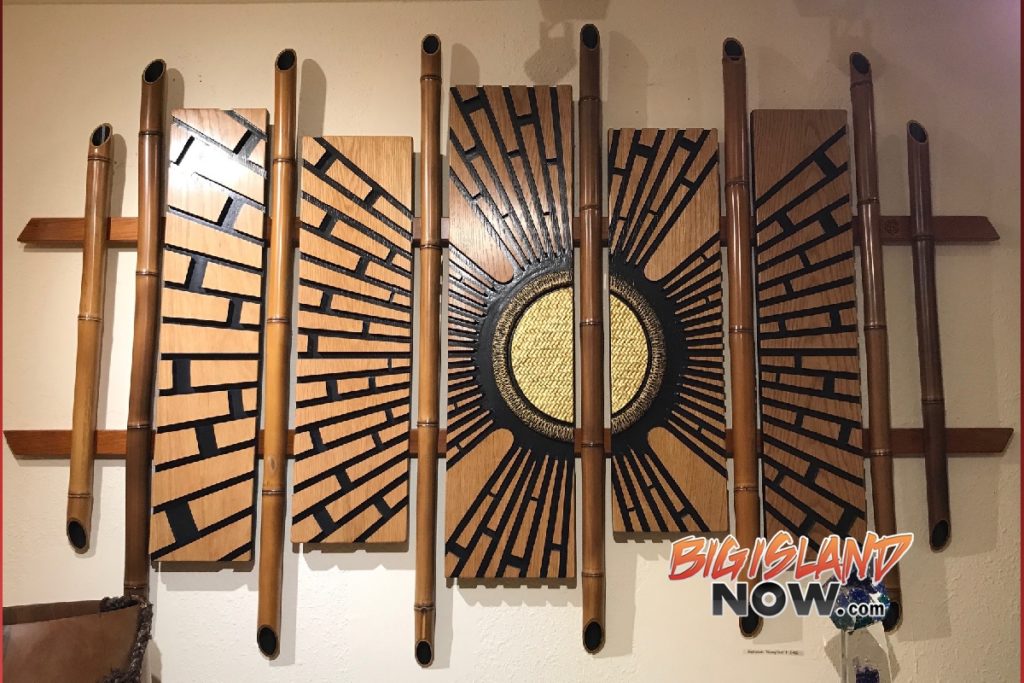Kahilu Theatre Presents ‘Confluence East’
Kahilu Exhibits presents, CONFLUENCE EAST: Ellen Crocker & Cal Hashimoto, from Thursday, Feb. 15, through Thursday, March 29, 2018. There will be an opening reception and artists’ walkthrough on Feb. 15 from 5 to 7 p.m., and a no-host bar and light pūpū will be available.
The exhibit showcases the artists Ellen Crocker and the late Cal Hashimoto, both of Hawaiʻi Island.
The selected works at the Kahilu Theatre Galleries include sculpture, paintings and mixed media works that reflect the artistsʻ shared interest in the art disciplines of Japan.
The title of the exhibition, Confluence East, is defined as the place where two rivers meet. When Hashimoto and Crocker first began discussing a joint proposal to Kahilu Exhibits in the fall of 2016, it was because they recognized that while their work was very different in form, they shared a passion for art disciplines of Japan. Throughout his career, Hashimoto was widely recognized for his intricate explorations in bamboo sculpture. Crockerʻs work utilizes Sumi-e, (Japanese ink brush), watercolor, carving and Roketsu-zome (Japanese batik) to create mixed media paintings, art quilts and works on wood.
Hashimoto (1945 – 2017) was a mixed media artist whose interest in sculpture began at a young age in California, when he first began carving figures out of eucalyptus and almond logs with a chainsaw. His sculptural interest was refined during study at the University of California at Berkeley under the influence of artists Peter Voulkos and John Battenburg, as well as during extended travels in West and East Africa, Southeast Asia, China, Indonesia, Europe, Japan, Canada, Mexico and Central America.
Hashimoto moved to the Big Island of Hawai‘i in 1982 where he found drama and beauty in the island’s culture and natural materials, and incorporated them into his work.
In a personal art statement he said, “My explorations led to the discovery of the various bamboo groves that are found throughout the islands. There was always a serenity and beauty to these environments that transported me into a spiritual place of my own being. My primary sculptural medium had been metals, wood and natural fibers, however, since 1990, I have been exploring my creative expression through the use of bamboo. The difficult task that I endeavor to accomplish is to incorporate some of the aspects of serenity, beauty, and spirituality of a bamboo forest into my art work. This coupled with the influences of ten years of travel and exposure to the arts of different cultures has formed the basis of what is now embodied in my bamboo sculpture.”
Hashimoto held a Bachelor of Architecture Degree University of California, Berkeley and he was a Registered Architect at ARIBA (Africa Royal Institute of British Architects) in Kenya, East Africa. Because he had background and training in architecture, Hashimoto was able to develop new joining methods which responded to the difficult requirements of enduring sculpture. He was credited with inventing new ways to work with bamboo that had not been used before and his mastery and joining techniques were widely recognized. Hashimoto was included in such publications as The Craft & Art of Bamboo (Larks Books, 2002), Bamboo Style (Gibbs Smith, 2002) and the International Bamboo Congress Compendium (1998).
Also exhibiting in CONFLUENCE EAST is mixed-media artist Crocker, whose studio practice includes painting, stitching and carving. Her works on view at Kahilu Exhibits will include works on silk, using the techniques of Roketsu-zome (Japanese wax resist) and Sumi-e (ink painting), as well as works in wood, which will include hand relief carved birch panels that incorporate graphite and acrylic paint.
Crocker arrived in Hawai‘i in 1974, and chanced upon a group of Nisei Japanese learning Sumi-e taught by Sensei Koh Itoh, from Kanazawa, Japan. He became her mentor and friend until he passed away at 92. This proved to be a seminal time in her development as an artist.
“The greatest influence in my life has been the art of Sumi-e (ink painting).I had no idea where this passion for Japanese art would carry me,” said Crocker. “Sumi-e has taken me twice to Kyoto, Japan to study. These experiences deepened my depth of painting with ink. It is the foundation for my work. The medium I am working in at the moment may not be ink, but the simplicity, the brush strokes, the fluidity, the freedom, all come from Sumi-e.”
Crocker has exhibited her work in numerous solo and group exhibitions. She has been the recipient of many awards, including an ʻ09 Recent Acquisitions from the Art in Public Places Collection, Hawai‘i State Art Museum(HISAM) and Finalist, International Quilt Association Annual Show in Houston, Texas. Her work is in the permanent collection of such public institutions as the Hawai‘i Medical Service Association and the Hawai‘i State Art Museum, as well as being held in private collections in the United States, Japan, Canada, the Netherlands and Germany. Crocker has taught art in Hawai‘i since 1982, including her current position of Advanced Teaching Artist of Hawai‘i, where she writes AITS grants for schools and teaches in the South Kona Public Schools.
The Kahilu Theatre Galleries exhibitions are free and open to the public Monday through Friday, from 9 a.m. to 1 p.m. and during all performances. For more information, go online or call (808) 885-6868.
















